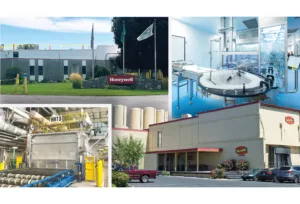AmericanWest targets regional status
Institution expects to reach $1 billion in assets this year, consolidate after growth
Wes Colley estimates that AmericanWest Bancorp.s assets will reach $1 billion this year, and its geographic reach now includes 42 branches in more than 30 cities in Eastern Washington and North Idaho.
Within three years, Colley, who is president and CEO of the Spokane-based financial institution, expects AmericanWest to have 50 branches and assets of about $1.3 billion.
Its getting harder to call ourselves a community bank, he muses.
With long-range plans to expand into Southern Idaho and Western Washington, AmericanWest definitely is targeting regional-bank status, Colley says. AmericanWest has been looking at the Seattle, Boise, and Vancouver, Wash., markets but is waiting for now to enter them because all three have seen a high level of banking activity in recent years, and we dont want to be the last guy in, he says.
For now, Colley says hed like to work on ironing out any remaining kinks from the five-bank consolidation that created AmericanWest Bancorp in 2001. That event brought together under the AmericanWest name United Security Bank, of Spokane; Home Security Bank, of Sunnyside, Wash.; AmericanWest Bank, of Walla Walla, Wash.; Bank of Pullman, of Moscow, Idaho; and Grant National Bank, of Ephrata, Wash.
Last year, AmericanWest acquired Latah, Wash.-based Bank of Latah, which operated nine branches in the Palouse and North Idaho.
Currently, AmericanWest Bank employs about 330 people.
Forging a common corporate culture among the employees and branches of what had been five separate banks is a big job, as is unifying various computer systems, Colley says. Yet, spending time doing both is probably the best thing that could happen to our bank right now, Colley says.
Another reason Colley isnt planning a major expansion in the near future: At 64, he says he plans to retire within two to three years.
Id really like to leave this bank being a fine-tuned, outstanding bank, and that takes a lot of internal work, he says.
Commercial focus
That doesnt mean AmericanWest will be idle in the coming months.
The bank will open a branch in Post Falls early next year, although it hasnt released the location of that facility or begun building it yet, and it recently opened a $1 million regional-operations center in the Tri-Cities thats similar to the center it opened earlier this year in the Spokane Valley.
AmericanWest also plans to establish a bigger presence in downtown Spokane, with new offices in a five-story building thats under construction at the former site of Thaddeus T. Thudpuckers Restaurant, on Browne Street, between Riverside and Sprague avenues. The structure will carry AmericanWests name, which will lend prestige to the bank, Colley says.
He says the new downtown location will help underscore AmericanWests focus on commercial banking, especially commercial real estate construction and development, because it will be so much more convenient for business customers than the banks current downtown branch at 222 N. Wall. The bank hasnt decided whether it will close the Wall Street branch after it opens on Browne late this year or early next year.
Currently, about 75 percent of the banks lending business is commercial and agricultural, about 15 percent is residential real estate, and about 10 percent is consumer, such as auto and boat loans, Colley says.
Although AmericanWest tends to have much, and sometimes most, of the business in the small towns in which it operates, thats not the case in larger cities, he says.
AmericanWest accounts for less than 5 percent of all deposits in financial institutions that are insured by the Federal Deposit Insurance Corp. in both Spokane and Yakima, Wash., and in the Tri-Cities, AmericanWest accounts for less than 2 percent of total deposits, he says.
Those low figures give AmericanWest, which is publicly traded on the Nasdaq exchange, ample room for growth, he says.
Dont look for the bank to fuel that growth by adding a lot of services, such as insurance, leasing, or factoring receivables, Colley says. The bank or its predecessor institutions already have tried a number of add-on businesses to boost revenues and found that they werent a great fit, often because those banks didnt have the expertise to compete well in those niche markets, he says.
Any growth the bank experiences in the coming years is just going to come, really, from taking it from the competition, he says.
It also could come through further acquisitions, and Colley says hes always on the lookout for suitable candidates.
In 2002, AmericanWest reported record net income of $10.9 million, or $1.33 a share, up from $8.9 million, or $1.08 per share, the previous year. The 2001 results didnt include a one-time gain of $392,000 from the sale of the companys insurance subsidiary. AmericanWests assets as of Dec. 31 were $916.8 million, up from $659.3 million at the end of 2001. Its deposits were $766.3 million, compared with $532.2 million a year earlier, and loans were $764.9 million, up from $587.5 million.
Addressing problem loans
Colley says another focus in the coming year will be to reduce the banks level of nonperforming assets, which he readily admits are excessive. Nonperforming assets are loans on which borrowers are in default.
In 2002, AmericanWests nonperforming assets increased to $21.4 million, or 2.34 percent of total assets, compared with $14.8 million, or 2.25 percent the previous year.
Six loans made up $12.3 million of the total, including for two ice-skating rinks in the Spokane Valley that defaulted on their loans, and two apple orchards in the Yakima area.
The bank is trying to sell all four of those properties.
Although nonperforming assets were higher in 2002, Colley says, theres very little loss left in that number because AmericanWest already has written down those losses or believes it can sell the assets without taking further losses.
Jim Bradshaw, senior research analyst at D.A. Davidson & Co., backs up that contention, writing in his most recent research report on AmericanWest that loss severity appears to be modest.
AmericanWest took steps last year to deal with potential problem loans in the future by increasing its loan-loss reserve to $10.3 million, or 1.3 percent of total loans, as of Dec. 31, compared with reserves of $6.6 million, or 1.1 percent, at the end of 2001.
Colley says he plans to boost loan-loss reserves this year again to 1.4 percent of total loans, and hopes to reduce the banks level of nonperforming assets to less than 1 percent, the industry standard, he says.
Itll probably take me the next year to get that done, he says.
Related Articles

_c.webp?t=1763626051)

_web.webp?t=1764835652)
